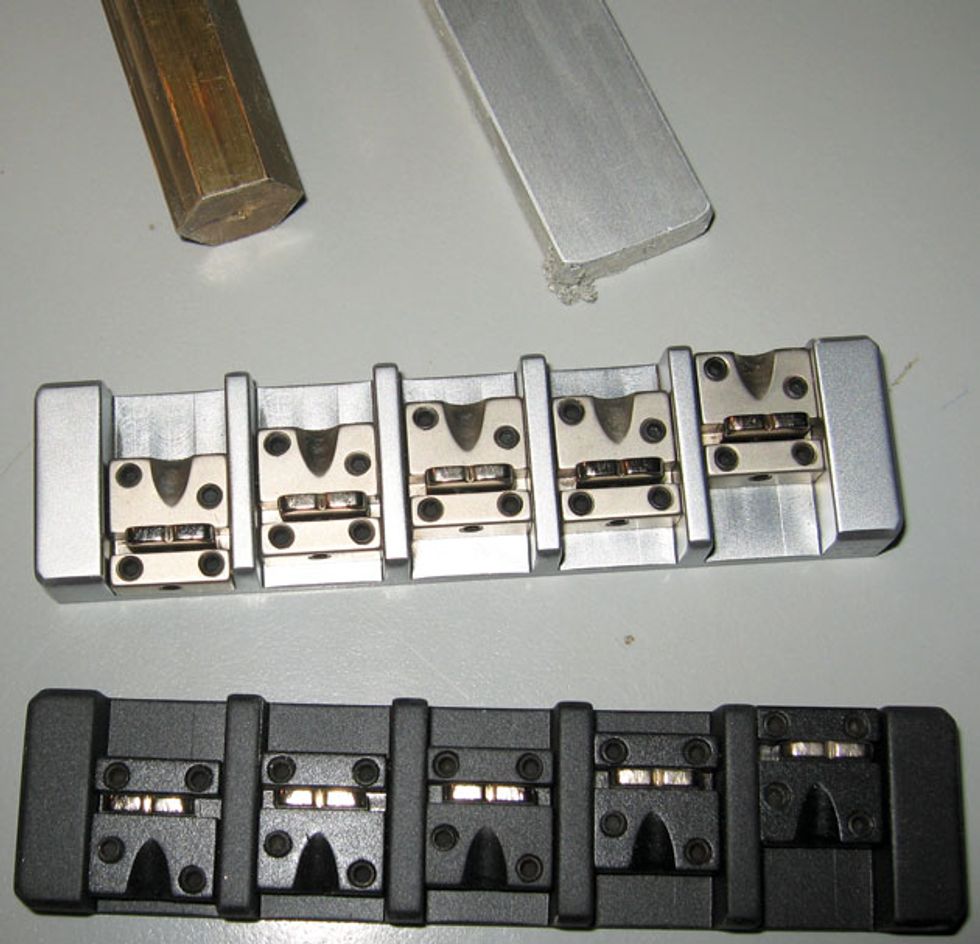When you bring your axe to a local shop for some minor repairs or a hardware upgrade, it gives you an opportunity to chat about the advantages or drawbacks of certain mods. You might also get a chance to physically inspect some uninstalled hardware, and this tactile experience can be quite instructive.
The whole point of modding a bass is to improve it aesthetically, sonically, or ergonomically. Photos and sound samples can guide your decisions in the first two categories, but many ergonomic decisions require personal, hands-on engagement.
Most of us only know the overall weight of our bass—too heavy, right?—but rarely do we know the weight of its various components. So once a player gets a chance to make a direct comparison between uninstalled solid brass and aluminum bridges, it prompts a question: “What if I replace all my standard hardware with the lightest available equivalents?” After hefting brass and aluminum bridges, one’s initial expectations are usually high. Of course, there are other considerations than simply weight. Do you like the tone or look of the new parts? Can you afford them? As the saying goes, your mileage may vary. But here’s a good question to start with: How much weight could I actually save?
The heaviest components that come to mind are those composed mostly of metal—the tuners, bridge, pickups, and even knobs. The market not only offers all these in many functional variations, but also made from different materials, which of course translates into different weights. Brass and steel are the materials that most often get replaced by aluminum. Here’s a first impression of what to expect by looking at the densities or specific weights of two common hardware metals expressed in grams per cubic centimeter (g/cm3):
• Brass 8.5
• Aluminum 2.75
And just for comparison: Most woods range within 0.4 to 0.8 g/cm3, which hints at why we don’t see many metal bass bodies—or at least no solid metal ones.
The fact that aluminum’s density is more than three times lower than brass implies that any hardware made from aluminum is just a third the weight of its brass counterpart. Unfortunately, aluminum lacks hardness, so all screws and many load-bearing parts still need to be made from brass or steel. Nonetheless, the weight differences can be impressive.
the best sounding instrument.
Let’s begin with the tuners. Saving weight here makes a lot of sense because it fights neck heaviness and benefits the instrument’s overall balance. A standard bass tuner weighs in at approximately 60 grams, while the lightest aluminum versions are 36 grams, which means a reduction of 40 percent.
And in the case of the aforementioned bridges, you can easily drop from 250 grams to a mere 90 grams. That’s a 60-percent weight reduction. Typical 5-string humbuckers weigh about 200 grams, while the Lace Aluma pickups go as low as 70 grams—a reduction of 50 to 70 percent.
Swapping knobs is the easiest and cheapest way to trim weight. And presumably not even the most diehard vintage purist would claim that moving from a 30-gram brass knob to a 4-gram plastic or aluminum knob—a weight savings of more than 80 percent—would extract a sonic penalty.
Now let’s sum up what we could potentially save on a 5-string bass with five controls that weighs a total of 4 kilograms or 8.8 pounds in its original condition: 670 grams or 1.4 pounds—about 15 percent of the bass’ overall weight. Does this really justify the presumed cost? And even if you have a lot of expertise gauging the potential tonal effect of swapping out parts, it’s hard—or even impossible—to know what you’ll sonically end up with after changing this much hardware.
So far we’ve been targeting parts made of the densest materials, but more voluminous parts can easily add way more to the bottom line. Most Jazz-bass bodies range between 4 to 6 pounds, so you can save almost twice as much weight by replacing a heavy body than going after hardware.
Okay, back to the beginning: Does replacing parts make sense? It can, especially if there are parts you want to replace anyway, but it never makes sense to do all of the above. It costs more to trick out a bass this way than buy a new one, and you’ll never wind up with a better instrument than one that was originally conceived as a whole.
If your beloved bass feels oppressively heavy, here’s a thought: Keep it as it is and play it seated for practice and recording, and get a cheap light one for stage use. When we’re onstage we all want to present ourselves in the best light, but that doesn’t mean we have to be playing the best sounding instrument. The only ones who would likely hear the difference are other bassists, and they won’t buy your latest record anyway. If you sound good, bassists will credit the instrument’s manufacturer, but if you play well because you feel comfortable, the glory is on you.







![Rig Rundown: Russian Circles’ Mike Sullivan [2025]](https://www.premierguitar.com/media-library/youtube.jpg?id=62303631&width=1245&height=700&quality=70&coordinates=0%2C0%2C0%2C0)
![Rig Rundown: AFI [2025]](https://www.premierguitar.com/media-library/youtube.jpg?id=62064741&width=1245&height=700&quality=70&coordinates=0%2C0%2C0%2C0)












 Shop Scott's Rig
Shop Scott's Rig















































